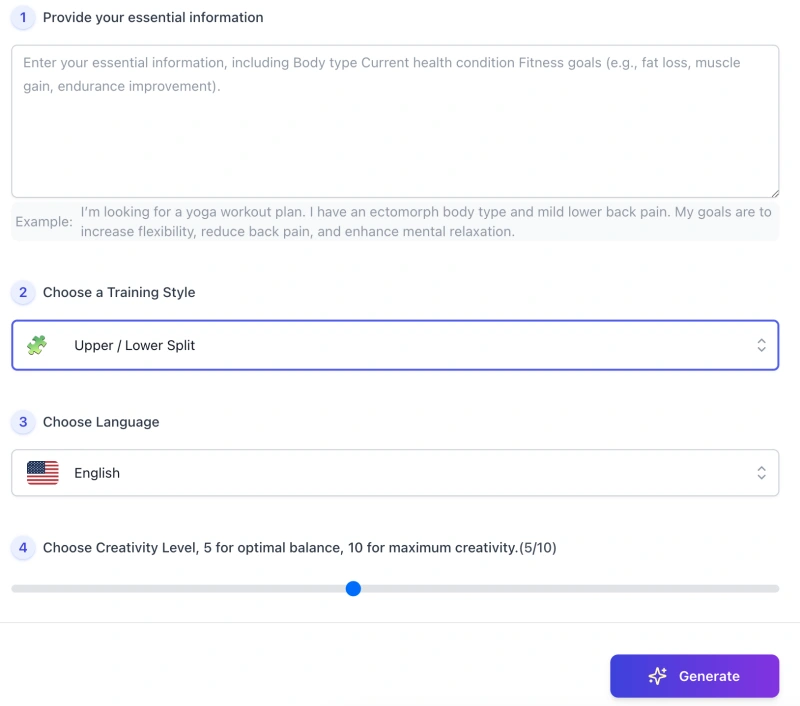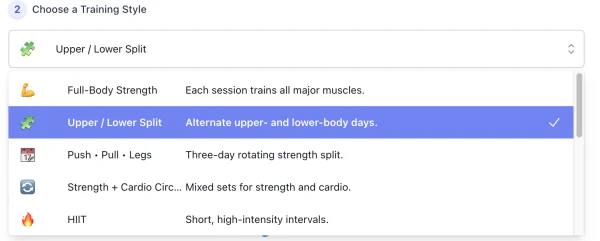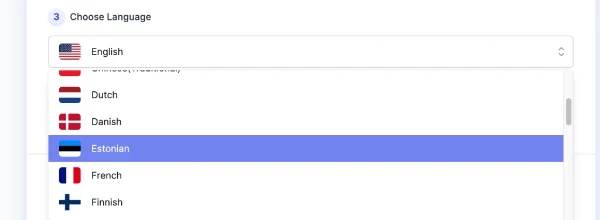Free AI Tools. No Sign-Up Required. Full Access.
AI Workout Generator
Create personalized workout plans instantly. Free, online, and no sign-up needed — designed for strength, cardio, flexibility, and home training.
Combine the current tool with these other tools to work more efficiently.
AI Meal Prep Ideas Generator
AI Kids Lunch Ideas Generator
AI Idea Generator
AI Introduction Generator
AI Advertisement Script Generator
AI Instagram Comment Generator
AI Instagram Post Generator
AI TikTok Comment Generator
AI TikTok Caption Generator
AI TikTok Ad Generator
Discover other tools with functions and purposes similar to the one you are currently viewing.
Discover the tools most favored and highly-rated by users on our website.
Explore more AI tools in these related categories
This is the AIFreeBox AI Workout Generator page – an online assistant for beginners, fitness enthusiasts, busy professionals, and anyone who wants structured training guidance. It helps you turn vague fitness goals into clear, personalized workout schedules and day-to-day exercise plans that fit your time, equipment, and experience level.
This page introduces the tool’s capabilities, use cases, step-by-step guidance, workout tips, limitations, troubleshooting advice, and FAQs — giving you a complete reference for building safe, effective, and sustainable workout routines with confidence.
What Can AIFreeBox AI Workout Generator Do?
The AIFreeBox AI Workout Generator is powered by transformer-based language models, designed to turn your basic input into clear, structured workout plans. It is not a coach or doctor, but a personalized fitness planning assistant that helps you move from vague goals to weekly schedules and daily routines.
With 12 training styles and support for 33 languages, the tool adapts to different goals, equipment, locations, and time limits. It creates exercise lists with sets, reps, rest times, and substitutions, plus low-impact and recovery-friendly options to keep training safe and sustainable.
The core value is human–AI collaboration: the AI builds structure, variety, and progression, while the user makes real-time decisions — adjusting intensity, swapping exercises, or updating inputs based on personal feedback. This ensures every plan stays practical, flexible, and motivating.
AIFreeBox AI Workout Generator vs. Generic Advice
Generic tips are a starting point; this tool turns your inputs into structured, adjustable plans.
| 🔎 Aspect | ⚡ AI Workout Generator | 📄 Generic Advice |
|---|---|---|
| 🎯 Personalization | Matches goals, time, equipment, level, and style | One-size-fits-all; little or no tailoring |
| 📅 Structure | Weekly schedules and daily exercise breakdowns | Loose guidelines; lacks actionable routines |
| 💡 Flexibility | 12 styles, substitutions, low-impact options | Limited variety; hard to adapt to constraints |
| 🌍 Accessibility | 33 languages; works at home, gym, or outdoors | Usually single language; context-agnostic |
| 🤝 Human–AI Balance | AI builds structure; user fine-tunes from feedback | User must interpret and modify alone |
| ⚠️ Safety | Caution notes, low-impact swaps, 4-week progression | No built-in safety context; overtraining risk |
Recommend Use Cases and Problem Solved
Different people struggle with different barriers to fitness — here are key situations where this tool makes training easier and more consistent:
| 🔎 Scenario | 💡 Problem Solved | 👥 Who Benefits |
|---|---|---|
| ⏱️ Limited Time | Creates short, efficient plans that fit lunch breaks or busy days | Working professionals, students |
| 🏠 Home Training | Designs workouts for no or minimal equipment | People training at home or on the go |
| 🎯 Lack of Structure | Provides clear weekly schedules and daily routines | Beginners unsure how to start |
| 🤕 Physical Limitations | Suggests low-impact and joint-friendly substitutions | Users with knee, back, or mobility concerns |
| 🌍 Language Access | Delivers plans in 33 languages | International users, non-English speakers |
| ⚡ Plateau & Boredom | Offers 12 training styles to add variety and progression | Intermediate users seeking new challenges |
| 💭 Motivation | Includes tips, consistency reminders, and achievable progressions | Anyone struggling to stay consistent |
How to Make A Workout Plan with AIFreeBox AI:
Step-by-Step Guide

Step 1. Provide Your Essential Information
Enter your key details such as body type, health condition, fitness goals, available time, and equipment. The clearer your input, the more accurate and useful the workout plan will be.
Step 2. Choose a Training Style

Select from 12 available workout styles (e.g., Full-Body Strength, HIIT, Yoga Flow). Each style adjusts the training structure to fit your goals and experience level.
Step 3. Choose Language

Pick from 33 supported languages. Plans are generated directly in your chosen language for better clarity and accessibility.
Step 4. Adjust Creativity Level
Use the slider to set the creativity level. A mid-level (around 5) ensures balanced, structured plans, while higher levels (up to 10) provide more variety and creative workout combinations.
Step 5. Generate Your Plan
Click Generate to create your personalized workout plan. The tool will turn your input into a detailed schedule with exercises, sets, reps, rest times, substitutions, and progression guidance.
Step 6. Download or Copy
Once the plan is generated, you can Download it for offline use or Copy it directly for quick reference and sharing.
Step 7. Report Bug & Feedback ( Real Human Support )

If you encounter issues or notice errors, click Report Bug. Your feedback goes directly to our support team, where real people are ready to review and resolve problems quickly. This ensures continuous improvement and a better user experience.
Reminder: The AI translates your input into structured workouts (splits, HIIT, full-body, etc.), providing exercise tables, sets, rest intervals, substitutions, RPE/Zone2 guidance, low-impact options, and progressive plans. You remain in control — adjust based on your body’s feedback, pause or swap exercises when needed, and update your input anytime for refined results.
Smart Workout Tips to Get the Most Out of This Tool
As any good coach will tell you — the best plan is the one you can actually follow. Here are some simple ways to guide the AI and make smart adjustments along the way.
💡 Getting the Plan You Really Want
- 📝 Be clear about your goal — whether it’s fat loss, muscle gain, or just staying active, the more specific you are, the better the plan fits.
- 🎯 Mention your fitness level — beginner, intermediate, or advanced. This helps the tool match exercises to your ability.
- ⏱️ Set your time limits — short on time? Tell the tool you have only 20–30 minutes and it will adjust your sessions.
- 🏠 Say where you train — at home, in the gym, or outdoors. You’ll get practical options that suit your space.
- 🌍 Pick your language — clear instructions in your preferred language make the plan easier to follow consistently.
⚡ Fine-Tuning Like a Pro
- 🤔 Listen to your body — if an exercise feels painful or unsafe, stop and use the suggested alternative.
- 🔄 Adjust intensity on the fly — drop the weight, reduce reps, or extend rest if needed; push harder only when recovery feels good.
- 📌 Update your input anytime — new goals, fresh constraints (like knee-friendly or low-impact)? Just re-enter and refine your plan.
- ⏳ Progress gradually — follow the 4-week structure, but add more only when your body is ready.
- 🤝 Keep control in your hands — the AI gives structure, but you decide when to stop, swap, or lower the load.
Think of the AI as a training partner that lays out the structure, while you provide the real-world feedback. Together, that’s how consistent progress is made.
Real User Case Studies: How It Works in Practice
From a coach’s eye, plans only matter when they fit real life. These examples show how the tool creates structure and how users fine-tune it based on feedback.
🏠 Case 1: 20-Minute Home Workout for Beginners
User input: Beginner, no equipment, 20 minutes, 3×/week, goal: get started safely.
AI plan: Full-body bodyweight session (incline push-ups, squats/hip hinge, plank), 2–3 rounds, RPE 6–7, short warm-up and cool-down, low-impact substitutions provided.
User adjustment: Swapped jumping moves for step-ups, shortened planks from 45s to 30s on day one, added 30s rest between rounds.
Outcome: Completed 3 sessions weekly without knee discomfort; technique improved and confidence to continue increased.
💼 Case 2: Lunch-Break Strength Split for Busy Professionals
User input: Intermediate, gym access, 30 minutes at lunch, 3–4×/week, goal: stay consistent.
AI plan: Upper/Lower Split with compound lifts and brief accessory work; supersets to save time; 60–90s rests; 4-week progression with small load increases if recovery is good.
User adjustment: Shortened warm-ups on tight days; extended rest on heavy sets; used machines when racks were busy (tool’s suggested substitutions).
Outcome: Sessions fit reliably into lunch breaks; adherence improved; measured strength gains over 4 weeks.
🦵 Case 3: Low-Impact Fat-Loss Plan for Knee Sensitivity
User input: Beginner, knee-friendly only, home or gym bike available, goal: fat loss.
AI plan: Low-impact circuit with Zone-2 cycling (20–30 min), glute bridges, dead bug, step-ups, gentle mobility; RPE 6–7; substitutions listed for any knee-loaded moves.
User adjustment: Replaced lunges with step-ups; kept cadence easy; added bands later as comfort improved.
Outcome: Steady weight loss without flare-ups; walking endurance improved; user felt safe progressing.
These scenarios reflect the core workflow: the AI turns your inputs into structured training (splits, HIIT, full-body, etc.) with exercises, sets, rest, substitutions, RPE/Zone-2 cues and 4-week progression; you stay in control—pause, swap, or lower the load when needed and update inputs anytime to refine the plan.
Style System Overview: Choose the Way You Like to Train
Different people train in different ways. Here’s a simple overview of the 12 workout styles available — explained in plain words so you can quickly find what fits you best:
- 💪 Full-Body Strength — train all major muscle groups in one session.
- 🧩 Upper / Lower Split — alternate between upper- and lower-body days.
- 📆 Push • Pull • Legs — a three-day rotation that balances strength training.
- 🔄 Strength + Cardio Mix — combine lifting and heart-rate work in one workout.
- 🔥 HIIT — short bursts of high effort with quick rests for fat burn and conditioning.
- 🚶 Steady Cardio (LISS) — low-intensity cardio like walking, cycling, or easy jogging.
- 🫧 Low-Impact Cardio — gentle cardio that’s easy on joints and safer for recovery.
- 🧘♂️ Core & Stability — focus on abs, balance, and posture support.
- 🤸 Mobility & Stretch — improve flexibility and recover with stretches.
- 🧘♀️ Yoga Flow — calming routines that blend strength, balance, and breathing.
- 🙌 Calisthenics — bodyweight training like push-ups, pull-ups, and dips.
- 🏃 Endurance Base — longer steady sessions to build stamina and lung capacity.
Limitations and Common Issues
No tool is perfect. Here are the main limitations of the AI Workout Generator, plus practical ways to handle them:
| ⚠️ Limitation | 🔍 What You Might Notice | 💡 Suggested Solution |
|---|---|---|
| Not a medical substitute | Plans don’t cover specific injuries or medical needs | Consult a doctor or physiotherapist before training |
| Dependent on input quality | Vague goals produce generic results | Be clear about goals, time, equipment, and limits |
| No real-time feedback | AI can’t see your form or effort | Use mirrors, record yourself, or ask a trainer to check |
| Progress varies | Results differ based on lifestyle, nutrition, recovery | Track sleep, diet, and consistency along with workouts |
| Requires self-adjustment | Some exercises may feel too hard or unsafe | Swap with low-impact options or reduce load/reps |
| Technical errors | Formatting issues, missing exercises, or plan not loading | Use the Report Bug button — our team will review |
| Motivation still needed | AI gives structure but can’t make you train | Set reminders, train with friends, celebrate milestones |
FAQs
Is this tool a replacement for a personal trainer or doctor?
No. It is an educational assistant that generates structured workout ideas. It does not replace professional medical advice or a certified trainer. Always consult a specialist if you have health concerns.
How accurate are the workout plans?
The plans are structured and goal-oriented, but outcomes depend on your input, consistency, recovery, and lifestyle. Treat them as flexible guidance, not guaranteed results.
What if an exercise feels unsafe or painful?
Stop immediately. Use the provided low-impact or alternative options, or reduce the load, sets, or reps. User judgment is essential to keep training safe.
Can I use this tool if I have an injury?
Only with professional clearance. The tool offers general substitutions and low-impact suggestions, but it cannot design medical or rehab programs. Always check with a doctor or physiotherapist first.
How do I adjust if my schedule changes?
You can re-enter updated inputs anytime (e.g., fewer days per week, shorter sessions). The AI will generate a new structure while you remain in control of pacing and progression.
Will my personal input be stored or shared?
No. Your inputs are processed to generate a plan and are not used for public display or saved for others to see. Privacy is respected, and your information stays secure.
What if the plan looks too advanced for me?
Scale down — reduce sets, choose lighter variations, or shorten sessions. The AI provides structure, but you decide how to match it to your real capacity.
What should I do if I find errors or bugs?
Use the Report Bug option. Feedback goes directly to our support team, where real people review and fix issues to improve your experience.
Creator’s Note
The AI Workout Generator was built with a simple idea in mind: most people don’t need a perfect plan, they need a clear starting point. This tool is here to support you by turning your goals and situation into a structured routine — exercises, sets, rest, and safe alternatives — so you don’t feel stuck at the first step.
But it’s important to be clear: this is not a coach or a doctor. It cannot feel what your body feels. That’s where you come in. You make the calls — when to push harder, when to slow down, when to swap an exercise, or when to rest. The AI provides structure, you provide judgment.
My hope is that this balance helps you stay consistent, safe, and motivated. Think of the AI as a reliable training partner that lays out the framework, while you remain in control of every decision along the way. Together, that’s how sustainable progress is built.
2025-10-19
🏋️♂️ Start your workout the smart way — generate a personalized routine now.
Free, online, and ready anytime. Get structured exercise ideas that match your goals, fitness level, and preferred training style.